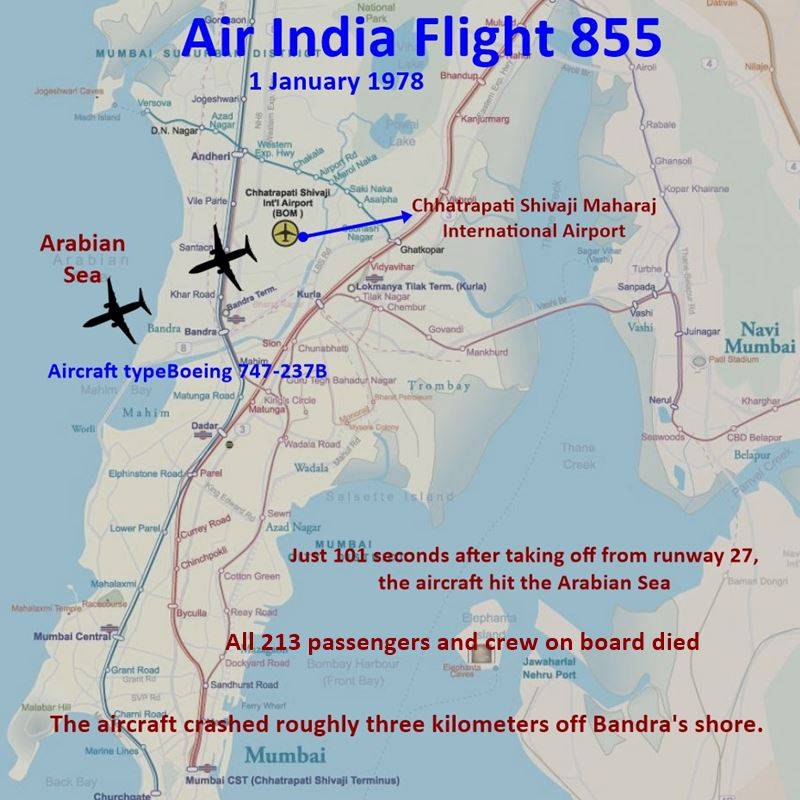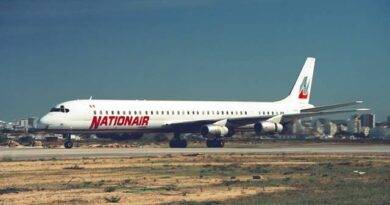Air India Flight 855: A Tragic Accident Caused by Human Error and Instrument Malfunction
On the evening of January 1, 1978, Air India Flight 855, a Boeing 747-237B named Emperor Ashoka, departed from Bombay’s Santa Cruz Airport (now Mumbai’s Chhatrapati Shivaji Maharaj International Airport) en route to Dubai. Tragically, the aircraft crashed into the Arabian Sea just 101 seconds after takeoff. The crash killed all 213 passengers and crew on board. (Wikipedia, Ace Archive). This disaster remains one of the deadliest in Indian aviation history, and its legacy continues to haunt the aviation industry.
The Aircraft and Crew
Emperor Ashoka was Air India’s first Boeing 747 and the pride of its fleet. Delivered in 1971, it was celebrated as a “palace in the sky” due to its luxurious interiors, including a first-class lounge on the upper deck adorned with Indian art murals (Bandra Buzz, Scroll.in). The aircraft had become symbolic of India’s emergence into the global aviation arena. Captaining Flight 855 that fateful night was Madan Lal Kukar, a veteran pilot with over 18,000 flying hours, accompanied by First Officer Indu Virmani, a former Indian Air Force pilot, and Flight Engineer Alfredo Faria (Bandra Buzz, Scroll.in).
Sequence of Events
Flight 855 took off from runway 27 at around 8:12 PM. Minutes after departure, air traffic control instructed the aircraft to report back upon reaching 8,000 feet.
Captain Kukar acknowledged the instruction and even wished the controller a Happy New Year. Eerily, this final greeting preceded the crash. (Scroll.in).
However, seconds into the flight, disaster struck. The plane’s Attitude Director Indicator (ADI)—an essential flight instrument that indicates the plane’s orientation relative to the horizon—malfunctioned. The captain’s ADI displayed a right bank, but the aircraft was actually level. When Captain Kukar attempted to correct what he believed was a right bank by turning left, he unknowingly worsened the situation. His first officer’s ADI also malfunctioned, further complicating the situation (Flight Safety Foundation, Ace Archive).
Flying over the dark Arabian Sea, with no visible horizon, the crew was unable to visually correct the aircraft’s orientation. Despite the efforts of Flight Engineer Faria, who urged Captain Kukar to rely on the third backup ADI located in the center panel, the captain continued to misinterpret the aircraft’s attitude (Ace Archive, Ace Archive). Within moments, the Boeing 747 banked left at a terrifying 108-degree angle, plunging nose-first into the sea at a 35-degree angle (Bandra Buzz). The plane disintegrated on impact, and all aboard were lost (Scroll.in, Ace Archive).
Investigations and Findings
The investigation into the crash, led by Indian aviation authorities, concluded that spatial disorientation caused by the faulty ADI was the primary cause. Despite the availability of functioning backup instruments, the crew’s inability to cross-check and respond to the aircraft’s true position led to the disaster. The Indian Directorate General of Civil Aviation (DGCA) emphasized the failure to utilize other available instruments, such as the backup ADI and turn and bank indicators (Flight Safety Foundation, Ace Archive).
Some initial reports suggested the possibility of sabotage. Witnesses claimed to have seen an explosion. However, after extensive investigation, these theories were dismissed. The crash was ruled an accident, primarily attributed to pilot error and equipment failure, with no signs of foul play.
Impact on the Aviation Industry
The Flight 855 disaster left a lasting scar on both Air India and the global aviation industry. It underscored the critical need for better crew resource management and pilot training in handling spatial disorientation and equipment malfunctions (CalendarZ : Whole world on a single site, Bandra Buzz). Boeing, along with the manufacturers of the faulty ADI, were cleared of negligence, though the crash prompted reviews of cockpit procedures and instrument reliability (Ace Archive, Scroll.in).
The memory of Emperor Ashoka persists in Indian aviation history. For years, locals in Mumbai’s Bandra suburb, near where the plane crashed, recalled the tragedy. People have attempted to memorialize the victims, but no official plaque or marker has been established to commemorate the lives lost that night.
(Scroll.in, Bandra Buzz).

Conclusion
The crash of Air India Flight 855 remains a somber reminder of the dangers inherent in aviation. Advances in technology have been significant. However, the event exposed the vulnerabilities that still exist. These weaknesses can emerge when human error and equipment failure converge in critical moments. Lessons from this tragedy have been embedded into the fabric of aviation safety practices, ensuring that the legacy of the Emperor Ashoka serves not only as a reminder of past sorrow but as a guide to preventing future calamities.
References:
- Flight 855 – Wikipedia: https://en.wikipedia.org/wiki/Air_India_Flight_855
- How An Instrument Malfunction Downed An Air India Boeing 747 45 Years Ago: https://simpleflying.com/air-india-flight-855-crash-anniversary/
- Air India 855 Flight Analysis – AviationKnowledge: http://aviationknowledge.wikidot.com/aviation:air-india-855-flight-analysis
- Image source: By Michel Gilliand – Gallery page http://www.airliners.net/photo/Air-India/Boeing-747-237B/0574902/LPhoto http://cdn-www.airliners.net/aviation-photos/photos/2/0/9/0574902.jpg, GFDL 1.2, https://commons.wikimedia.org/w/index.php?curid=27063890
- Map source: https://maps-mumbai.com/mumbai-outline-map


